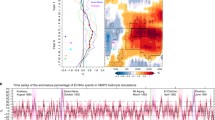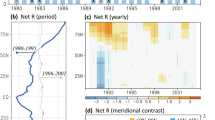Abstract
The frequent coincidence of volcanic forcing with El Niño events disables the clear assignment of climate anomalies to either volcanic or El Niño forcing. In order to select the signals, a set of four different perpetual January GCM experiments was performed (control, volcano case, El Niño case and combined volcano/El Niño case) and studied with advanced statistical methods for the Northern Hemisphere winter. The results were compared with observations. The signals for the different forcings are discussed for three variables (temperature, zonal wind and geopotential height) and five levels (surface, 850 hPa, 500 hPa, 200 hPa and 50 hPa). The global El Niño signal can be selected more clearly in the troposphere than in the stratosphere. In contrast, the global volcano signal is strongest in the stratospheric temperature field. The amplitude of the perturbation for the volcano case is largest in the Atlantic region. The observed effect of local cooling due to the volcanic reduction of shortwave radiation over large land areas (like Asia) in subtropical regions, the observed advective warming over Eurasia and the advective cooling over Greenland are well simulated in the model. The radiative cooling near the surface is important for the volcano signal in the subtropics, but it is weak in high latitudes during winter. A statistically significant tropospheric signal of El Niño forcing occurs in the subtropics and in the midlatitudes of the North Pacific. The local anomalies in the El Niño forcing region in the tropics, and the warming over North America in middle and high latitudes are simulated as observed. The combined signal is different from a simple linear combination of the separate signals. It leads to a climate perturbation stronger than for forcing with El Niño or stratospheric aerosol alone and to a somewhat modified pattern.
Similar content being viewed by others
References
AGU (1992) Volcanism and climate change. American Geophysical Union, Special Report
Asaturow ML, Budyko MI, Vinnikov KYa, Groisman PYa, Kabanov AS, Karol IL, Kolomeev MP, Pibobarova SI, Rosanov EV, Khmelevtsov SS (1986) Vulkani, stratospheri aerosol i klimat semli. Leningrad TRANS
Bakan S (1982) Strahlungsgetriebene Zellularkonvektion in Schichtwolken. Dissertation, University of Hamburg, Germany
Barnett TP, Latif M, Kirk E, Roeckner E (1991) On ENSO physics. J Clim 4:487–515
Berresheim H, Jaeschke W (1983) The contribution of volcanoes to the global atmospheric sulfur budget. J Geophys Res 88:3732–3740
Bjerknes J (1966) A possible response of the atmospheric Hadley circulation to equatorial anomalies of ocean temperature. Tellns 18:820–829
Blackmon ML, Geisler JE, Pitcher EJ (1983) A general circulation model study of January climate anomaly patterns associated with interannual variation of equatorial Pacific sea surface temperatures. J Atmos Sci 40:1410–1425
Bluth GJS, Doiron SD, Krueger AJ, Walter LS, Schnetzler CC (1992) Global tracking of the SO2 clouds from the June, 1991 Mount Pinatube eruption. Geophys Res Lett 19:151–154
Bradley RS (1988) The explosive volcanic eruption signal in Northern Hemisphere continental temperature records. Clim Change 12:221–243
Cubasch U (1985) The mean response of the ECMWF global model to the El Niño anomaly in extended range prediction experiments. Atmos Ocean 23:43–66
Cubasch U (ed) (1991) First joint climate modelling planning workshop 24th–25th June 1991. Deutsches Klimarechenzentrum Report
Davis JC (1973) Statistics and Data Analysis in geology. John Wiley, New York, pp 432–437
DKRZ (1992) The ECHAM3 atmospheric general circulation model. Techn Rep 6
Dzerdzeevskii BL (1962) Fluctuations of climate and the general circulation of the atmosphere in extratropical latitudes of the Northern Hemisphere and some problems of dynamic climatology. Tellus 14:328–336
Fraedrich K, Müller K, Kuglin R (1992) Northern Hemispheric circulation regimes during the extremes of the El Niño/Southern Oscillation. Tellus 44:33–40
Geller MA, Alpert JC (1980) Planetary wave coupling between the troposphere and the middle atmosphere as a possible sunweather mechanism. J Atmos Sci 37:1197–1215
Gobbi GP, Congeduti F, Adriani A (1992) Early stratospheric effects of the Pinatubo eruption. Geophys Res Lett 19:997–1000
Graf HF (1986) Abkühlung der Nordhemisphäre — ein möglicher Trigger für El Niño/Southern Oscillation Episoden. Naturwissenschaften 73:258–263
Graf HF (1992) Arctic radiation deficit and climate variability. Clim Dyn 7:19–28
Graf HF, Kirchner I, Robock A, Schult I (1993) Pinatubo eruption winter climate effects: model versus observations. Clim Dyn 9:81–93
Graf HF, Perlwitz J, Kirchner I (1994) Northern Hemisphere tropospheric midlatitude circulation after violent volcanic eruptions. Contrib Atmos Phys 67:3–13
Groisman PY (1992) Possible regional climate consequences of the Pinatubo eruption: an empirical approach. Geophys Res Lett 19:1603–1606
Halpert MS, Ropelewski (1992) Surface temperature pattern associated with the Southern Oscillation. J Clint 2:577–593
Hammer CU (1977) Past volcanism revealed by Greenland ice sheet impurities. Nature 270:482–486
Hasselmann K (1993) Optimal fingerprints for the detection of time dependent climate change. J Clim 6:1957–1971
Hense A (1986) Multivariate statistical investigations of the Northern Hemisphere circulation during the El Niño event 1982/83. Tellus 38:189–204
Hofmann DJ (1988) Aerosols from past and present volcanic emissions. In: Hobbs V, McCormick MP (eds) Aerosols and climate. Deepak, Hampton, pp 195–214
Horel JO, Wallace JM (1981) Planetary-scale atmospheric phenomena associated with the Southern Oscillation. Mon Weather Rev 109:813–829
Jones PD, Raper SCB, Cherry BSG, Goodness CM, Wigley TML, Sauter B, Kelly PM, Brandley RS, Diaz HF (1986) A global grid point surface air temperature data set: 1851–1984. CDIC Numeric Data Collection, NDP-020
Kiladis GN, Diaz HF (1989) Global climate anomalies associated with extremes in the Southern Oscillation. J Clim 2:1069–1090
Kinne S, Toon OB, Prather MJ (1992) Buffering of stratospheric circulation by changing amounts of tropical ozone — a Pinatubo case study. Geophys Res Lett 19:1927–1930
Kirchner I (1994) Der Einfluß vulkanischen Aerosols und simultaner Temperaturanomalien der tropischen Meeresoberfläche (El Niño) auf das Klimasystem. MPI Examensarbeit 21
Kodera K (1994) Influence of volcanic eruptions on the troposphere through stratospheric dynamical processes in the Northern Hemisphere winter. J Geophys Res 99:1273–1282
Krueger A (1983) Sighting of El Chichón sulfur dioxide clouds with the Nimbus 7 total ozone mapping spectrometer. Science 220:1377–1379
Labitzke K, Naujokat B (1983) Temperature effects on the stratosphere of the April 4, 1982 eruption of El Chichón, Mexico. Geophys Res Lett 10:24–26
Labitzke K, van Loon H (1989) The Southern Oscillation. Part IX: The influence of volcanic eruptions on the Southern Oscillation in the stratosphere. J Clim 2:1224–1226
Lacis A, Hansen J, Sato M (1992) Climate forcing by stratospheric aerosols. Geophys Res Lett 19:1607–1610
Lamb HH (1977) Supplementary volcanic dust veil index assessments. Climate Monitor 6:57–67
Lau NC (1985) Modeling the seasonal dependence of the atmospheric response to observed El Niños in 1962–76. Mon Weather Rev 113:1970–1996
Lough JM, Fritts HC (1987) An assessment of the possible effects of volcanic eruptions on North American climate using treering data, 1602 to 1900. Clim Change 10:219–239
Mass CF, Portman DA (1989) Major volcanic eruptions and climate: a critical evaluation. J Clim 2:566–593
Matsuno T (1970) Vertical propagation of stationary waves in the winter Northern Hemisphere. J Atmos Sci 27:871–883
Namias J (1976) Some statistical and synoptical characteristics associated with El Niño. J Phys Oceanogr 6:130–138
Newall CG, Self S (1982) The volcanic explosivity index (VEI): an estimate of explosive magnitude for historical volcanism. J Geophys Res 87:1231–1238
Palmer TN (1988) Medium and extended range predictability and stability of the Pacific/North American mode. Q J R Meteorol Soc 114:691–713
Palmer TN, Mansfield DA (1984) Response of two atmospheric general circulation models to sea-surface temperature anomalies in the tropical East and West Pacific. Nature 310:483–485
Palmer TN, Mansfield DA (1986a) A study of winter time circulation anomalies during past El Niño events using a high resolution general circulation model I: influence of model climatology. Q J R Meteorol Soc 112:613–638
Palmer TN, Mansfield DA (1986b) A study of winter time circulation anomalies during past El Niño events using a high resolution general circulation model II: variability of the seasonal mean response. Q J R Meteorol Soc 112:639–660
Perlwitz J, Graf HF (1994) On the statistical connection between tropospheric and stratospheric circulation of the Northern Hemisphere in winter. MPI Report 134, pp 33, in press J Climate, Oct. 1995
Philander SG (1990) El Niño, La Niña, and the Southern Oscillation. International Geophys Series 46. Dmowska R, Holton JR (eds) Academic Press
Pinto JP, Turco RP, Toon OB (1989) Self-limiting physical and chemical effects in volcanic eruption clouds. J Geophys Res 94:11165–11174
Preisendorfer RW (1988) Principal component analysis in meteorology and oceanography. Development in Atmospheric Science, 17, Elsevier, Amsterdam, pp 425
Quinn WH, Zopf DO, Short KS, Huo Yang RTW (1978) Historical trends and statistics of the Southern Oscillation; El Niño and indonesian drought. Fishery Bull 76:663–678
Reiter R, Jäger H (1986) Results of 8-year continuous measurements of aerosol profiles in the stratosphere with discussion of the importance of stratospheric aerosols to an estimate of effects on the global climate. Meteorol Atmos Phys 35:19–48
Robock A (1991) The volcanic contribution to climate change of the past 100 years. In: Schlesinger ME (ed) Greenhouse-gasinduced climate change: a critical Appraisal of Simulations and Observations. Elsevier Science, Amsterdam, pp 429–443
Robock A, Mao J (1992) Winter warming from large volcanic eruptions. Geophys Res Lett 19:2405–2408
Roeckner E, Dtimenil L, Kirk E, Lunkheit F, Ponater M, Rockel B, Sausen R, Schleese U (1989) The Hamburg version of the ECMWF model (ECHAM). In: Boer GJ (ed) Research Activities in Atmospheric and Oceanic Modelling. CAS/JSC Working Group on Numerical Experimentation. Rep 13, WMO/TD 332. 7.1–7.4
Russell PB, Pueschel R, Kinne S, Dutton E, Deshler T, Browell E, Stowe L, Post MJ (1993) Size distribution and optical properties of post-Pinatubo aerosols. Gordon Conference on the impact of volcanism on climate. Henniker, NH, July 26–30, 1993
Santer BD, Brüggemann W, Cubasch U, Hasselmann K, Hock H, Maier-Reimer E, Mikolajewicz U (1993) Signal-to-noise analysis of time-dependent greenhouse warming experiments. Part 1: pattern analysis. Clim Dyn 9:267–285
Schmitz G, Grieger N (1980) Model calculations of the structure of planetary waves in the upper troposphere and lower stratosphere as a function of the wind field in the upper stratosphere. Tellus 32:207–214
Schult I (1991) Bildung und Transport von Aerosolteilchen in der Stratosphäre und ihre Bedeutung für den Strahlungshaushalt. MPI Examensarbeit 11
Sear CB, Kelly PM, Jones PD, Goodess CM (1987) Global surface-temperature response to major volcanic eruptions. Nature 330:365–367
Shukla J, Fennessy MJ (1988) Prediction of time mean atmospheric circulation and rainfall influence of pacific SST anomaly. J Atmos Sci 45:9–40
Simkin T, Siebert L, McClelland L, Bridge D, Newhall CG, Latter JH (1981) Volcanoes of the world. Hutchinson Ross, Stroudsburg, PA
Spencer RW, Christy JR (1993) Precision lower stratospheric temperature monitoring with MSU: technique, validation, and results 1979–1991. J Clim 6:1194–1204
Spirina LP (1973) On the seasonal changes of the surface air temperature field of the Northern Hemisphere after volcanic eruptions (in Russian). Transactions of the Main Geophysical Observatory, Leningrad, 299:3–7
Storch H von, Kruse HA (1985) The extra-tropical atmospheric response to El Niño events — a multivariate significance analysis. Tellus 37:361–377
Storch H von, Zwiers FW (1988) Recurrence analysis of climate sensitivity experiments. J Clim 1:157–171
Taubenheim J (1974) Zur Berücksichtigung der Autokorrelation bei statistischen Tests von Durchschnitten, Streuungen und überlagerten Stichtagen. Gerlands Beitr Geophys 3:121–128
Turco RP, Toon OB, Whitten RC, Hamill P, Keesee RG (1983) The 1980 eruption of Mount St. Helens: physical and chemical processes in the stratospheric clouds. J Geophys Res 88:5299–5319
van Loon H, Labitzke K (1987) The Southern Oscillation. Part V: the anomalies in the lower stratosphere of the Northern Hemisphere in winter and a comparison with the Quasi-Biennial Oscillation. Mon Weather Rev 115:357–369
Wendler G (1984) Effects of the El Chichón volcanic cloud on solar radiation received at Fairbanks, Alaska. Bull Am Meteorol Soc 65:216–218
Wright PB (1991) Homogenised sea surface temperature from the COADS and sea surface temperature from Climate Diagnostic Bulletin, Climate Analysis Center
Author information
Authors and Affiliations
Rights and permissions
About this article
Cite this article
Kirchner, I., Graf, HF. Volcanos and El Niño: signal separation in Northern Hemisphere winter. Climate Dynamics 11, 341–358 (1995). https://doi.org/10.1007/BF00215736
Received:
Accepted:
Issue Date:
DOI: https://doi.org/10.1007/BF00215736




